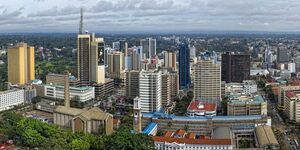A number of buildings boasting exquisite architectural designs have come up in Nairobi City and redefined it's skyline.
The race to the clouds is not subsiding anytime soon with the most recent developments being a 33-storey UAP Tower in Upper Hill, UoN towers, Parliament buildings and One Africa Building in Westlands.
Meanwhile, a host of other skyscrapers are still under construction.
As the new buildings are coming up, there are those that have stood the test of time, habouring over a hundred years of history while upholding their iconic standards.
Kipande House
Completed in 1913, Kipande House served as the registration point for Kenyans seeking identity cards (IDs) which is the building acquired its name kipande which is Swahili word for ID card.
The building which was designed by Gurdit Singh Nayer, a Pakistan national, still stands at the corner of Kenyatta Avenue and Loita Street.
It is one of the oldest standing structures in Nairobi, and was gazetted as a national monument.
In 1976, the building which boasts rich historical value, was bought by the Kenya Commercial Bank.
Till today, it still boasts of its smooth dressed bluestone walls with ornate arches to the front façade.
Nyayo House
Situated along Kenyatta Avenue, many people associate Nyayo House with the provision of immigration services in the country.
During the Moi era, the building was known for its use as torture the chambers for those who were perceived to oppose the regime. The torture chambers were located in the basement of Nyayo House.
Construction of the building started in 1979, one year after Daniel Arap Moi took over as the second president of Kenya, and was completed in 1983. It stands at 84 metres high with 27 floors.
Times Tower
Before UAP Towers took the crown for the tallest building in the country, Times Towers reigned supreme with 140 Metres.
Completed in May 2000, Times Tower was officially known as the New Central Bank Tower sitting along Haile Selassie Avenue.
The building was built by the Central Bank of Kenya as the government’s main tax collection centre, and houses the Kenya Revenue Authority (KRA).
It has a seven-storey banking hall and an 11 split storey car park of reinforced concrete construction.
Kenyatta International Convention Centre (KICC)
Kenyatta International Convention Centre (KICC) was designed by the Norwegian architect Karl Henrik Nøstvik and our Kenyan David Mutiso. It was constructed in the late 1960s.
The 28 storey building fondly referred to as the” KICC” has been and still is an iconic landmark for Kenya since its completion.
One of the designers, Mutiso, made headlines when he disclosed that the building was designed with a donkey's penis in mind.
“They wanted to build a headquarter for Kanu. We started sketching, initially, it was a simple four-storey building, it evolved with time. Every time we showed the President, he asked us to go higher and eventually we ended up with 17 floors,” he stated.
In an interview in 2018, Geneva-based architect and urban researcher, Prof Manuel Herz, pointed out that an architectural design was never done just by a single person.
“A design of a complex building like the KICC always happens in conversation and exchange with several designers.
"So I am sure that Mutiso had his input on the design in the years until 1970, but that Nøstvik was either the main architect of the building (signing the drawings) or at least majorly involved during that time. After 1970, Nøstvik can clearly be seen as the lead designer,” he stated.
Macmillan Memorial Library
MacMillan Memorial Library is one of the iconic buildings of the 1930s in Nairobi’s central business district.
The Library has a unique design as it was built with Nairobi Blue Stone, a hard stone that gives it that classic look and zero need for paint.
"The library is built using the Nairobi blue stone and finished with a very well-done plaster that requires no paint on the outside walls. Buildings such as these in Europe have lasted hundreds of years. Blue stone is a hard stone. It’s very good for construction," architect and environmental design expert Musau Kimeu stated in a previous interview.
Kenya National Archives
Kenya National Archives and Documentation Services (KNADS) is situated at the edge of the central business district in downtown Nairobi along Moi Avenue next to Ambassadeur Hotel.
Established in 1965, the archives look out on the landmark Hilton Hotel, while on the rear side is Tom Mboya street. It was established in 1965.
It was established by an Act of the Parliament of Kenya in 1965 and was placed under the office of the Vice President and the Minister of Home Affairs. It is currently under the office of the Vice-President and State Department for National Heritage and Culture.












